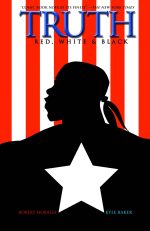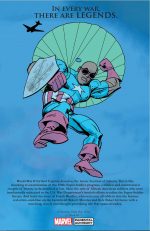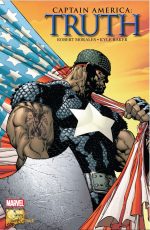


By Robert Morales, Kyle Baker & various (MARVEL)
ISBN: 978-1-3029-3427-9 (TPB/Digital Edition) 978-0785136668 (Premiere HB)
It’s never been more apparent than these days, but Truth is a Weapon. Facts, events and especially interpretations have always been manipulated to further a cause, and that simple premise was the basis of one of the most groundbreaking and controversial comic book stories of all time…
Created by Joe Simon & Jack Kirby in an era of frantic patriotic fervour, Captain America was a dynamic and highly visible response to the horrors of Nazism and the threat of Liberty’s loss. Consequently, the concept quickly lost focus and popularity after hostilities ceased. Fading away during post-war reconstruction, only to briefly reappear after the Korean War: a harder, darker sentinel ferreting out monsters, subversives and the “Reds” who lurked under every American bed.
He abruptly vanished once more, until the burgeoning Marvel Age resurrected him just in time to experience the Land of the Free’s most turbulent and culturally divisive era. Cap quickly became a mainstay of the Marvel Revolution during the Swinging Sixties, but lost his way after that, except for a politically-charged period under scripter Steve Englehart.
Despite everything, Captain America became a powerful symbol for generations of readers and his career can’t help but reflect that of the nation he stands for…
Devised in the Autumn and on newsstand by December 20th 1940, Captain America Comics #1 was cover-dated March 1941 and an instant monster, blockbuster smash-hit. The Sentinel of Liberty had boldly and bombastically launched in his own monthly title with none of the publisher’s customary caution, and instantly became the absolute and undisputed star of Timely’s top-selling “Big Three” – the other two being The Human Torch and Sub-Mariner. He was, however, one of the first to fall from popularity as the Golden Age ended.
For all that initial run, his exploits were tinged – or maybe “tainted” – by the sheer exuberant venom of appalling racial stereotyping and heady fervour of jingoism at a time when America was involved in the greatest war in world history. Nevertheless, the first 10 issues of Captain America Comics are the most exceptional comics in the fledgling company’s history…
You know the origin story as if it were your own. In ‘Meet Captain America’ Simon & Kirby revealed how scrawny, enfeebled patriot and genuinely Good Man Steven Rogers, after being continually rejected by the US Army, is recruited by the Secret Service.
Desperate to stop Nazi-sympathizing atrocity, espionage and sabotage, the passionate teen accepts the chance to become part of a clandestine experimental effort to create physically perfect super-soldiers. However, after a Nazi agent infiltrates the project and murders the pioneering scientist behind it, Rogers is left as the only successful graduate and becomes America’s not-so-secret weapon.
For decades the story has been massaged and refined, yet remained essentially intact, but in 2002 – in the wake of numerous real-world political and social scandals (like the Tuskegee Experiment/Tuskegee Syphilis Study 1932-1972) – writer Robert Morales (Vibe Magazine, Captain America) & Kyle Baker (Nat Turner, Plastic Man, The Shadow, Why I Hate Saturn) took a cynical second look at the legend through the lens of the treatment of and white attitudes towards black American citizens…
The result was Truth: Red, White & Black #1-7 (January-July 2003), initially collected as a Premiere Hardcover edition in 2009 and here in trade paperback and digital formats. This hard-hitting view of the other side of a Marvel Universe foundational myth forever changed the shape of the continuity: using the tragedy and inherent injustice of the situation to add to the pantheon more – and more challenging – heroes of colour and contemporary role models.
‘The Future’ begins at “Negro Week” of the 1940 New York World’s Fair where Isaiah Bradley and his bride Faith learn yet again they are still second class citizens, and that their rights and freedoms are conditional. December in Philadelphia sees young firebrand and workers’ rights activist Maurice Canfield painfully realise that even his father’s hard-earned wealth and position mean nothing as long as their skin is dark in America…
Cleveland in June of 1941 and negro war veteran “Black Cap” is still in the army. It’s fiercely segregated and he’s been demoted to sergeant, but Luke Evans is content to have work and purpose. Since returning from the Great War, Evans has lived through so much crap – even a year of race riots and near-revolution that threatened to wipe out his kind – that he’s content to take each day as it comes.
Everything changes for these black men and thousands like them when the Japanese attack Pearl Harbor on December 7th 1941…
‘The Basics’ opens in 1942 at Camp Cathcart, Mississippi. The base is tense, and strife between partitioned white and black recruits at a perilous boiling point. Brawling between races is constant. Into the explosive situation comes oily G-Man Homer Tully and scientist Dr. Josef Reinstein who petition openly racist commander Major Brackett to give them two battalions of coloured recruits and cover up the fact that they ever existed…
Wartime secrecy is then employed to mask an appalling act of racist cynicism, as hundreds of patriotic black men are trained and callously discarded as Reinstein methodically perfects his super-soldier serum on expendable lower race guinea pigs.
The scene switches to Project Super Soldier (location classified) where Colonel Walker Price supervises ‘The Passage’ of the survivors from human to something else. Bradley, Canfield, Evans and the others have endured a cruel barrage of chemical interventions. Of three hundred, only a handful survive, and all are radically changed… or, more accurately, mutated. Reinstein is acutely aware that his former colleagues in Nazi Germany are just as close to solving the riddle of superhumanity and pushes on with increasing disregard for the laws of science or ethics of civilisation…
Next of kin are informed that their loved ones have been killed in training, but Faith Bradley knows the corpse in the casket is not her man and starts making waves…
Ultimately, military pragmatism supersedes scientific caution and the seven remaining negros – all immensely powerful in radically changed bodies – are pressed into action as an expendable super-suicide squad. Commanded by white supremacist Lieutenant Philip Merritt, ‘The Cut’ sees them deployed to the Black Forest with orders to destroy the rival Uber-mensch project. The mission catastrophically fails, but survivor Isaiah Bradley is coerced by Walker Price into returning to Germany on a solo suicide mission to eradicate the facility. Apparently, the “real” Captain America is unable to get there in time…
Rebellious to the end, Bradley complies, but steals and dons the flashy star-spangled uniform worn by the public – blue-eyed, blonde and exceeding white – face of America’s Super Soldier Project. It’s October 1942 and the last time the world hears from or about Bradley…
The horrors he saw and his spectacular triumph only start emerging in ‘The Math’ as – today in the Bronx – superhero Steve Rogers meets Bradley’s widow and discovers something truly astounding…
Whilst crushing domestic terrorism, Captain America had captured unrepentant mastermind Merritt and learned how the monster had been instrumental in Reinstein’s death decades previously. Further investigation uncovered ‘The Whitewash’ Merritt and his superior Walker Price instigated, and what they perpetrated after Bradley unexpectedly battled his way back to America…
Stunned to have unearthed a secret history of oppression and immorality that occurred all around him without his slightest inkling, Rogers is distraught and furious, resolved to set things right at all costs…
That mission takes him to the highest echelons of government and darkest corners of military intelligence in ‘The Blackvine’, where he learns more uncomfortable truths about his origins and the true nature of the country he loves and represents. Shellshocked and despondent, Cap returns to the Bradley’s home and gets a welcome if belated chance to salve his soul, set history straight and repay moral debts unknowingly incurred in his name…
With covers by Baker, promo art by Joe Quesada, Danny Miki & Richard Isanove, and unused cover treatments, this landmark saga is backed up with a context-laden, disturbingly informative Appendix by Robert Morales: clarifying and expanding on many previously sidelined moments of actual and black history that informed the story.
Powerful, engaging, enlightening and immensely gratifying, this is a story to enrage and enthral, and one no socially aware superfan should miss.
© 2022 MARVEL.
